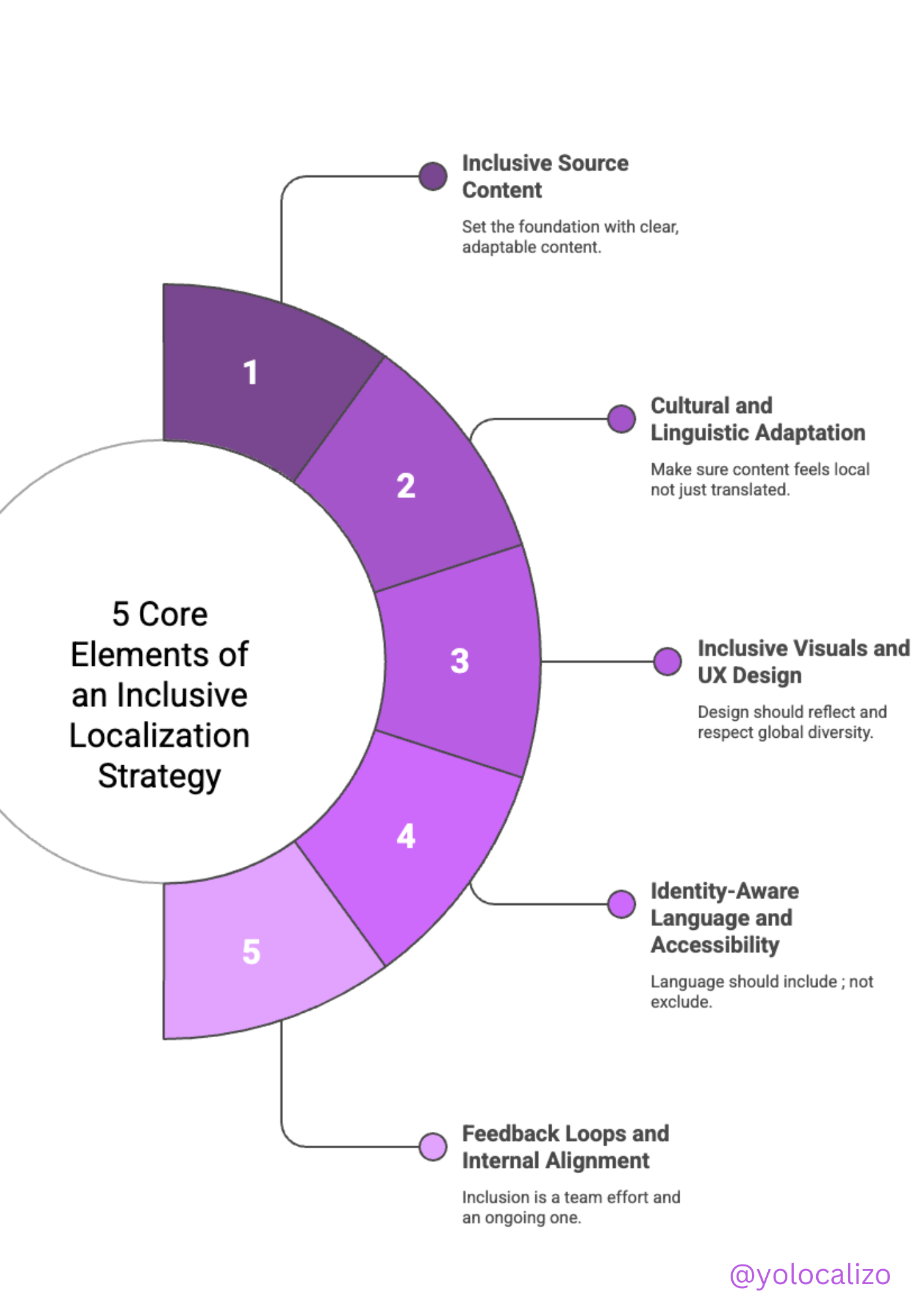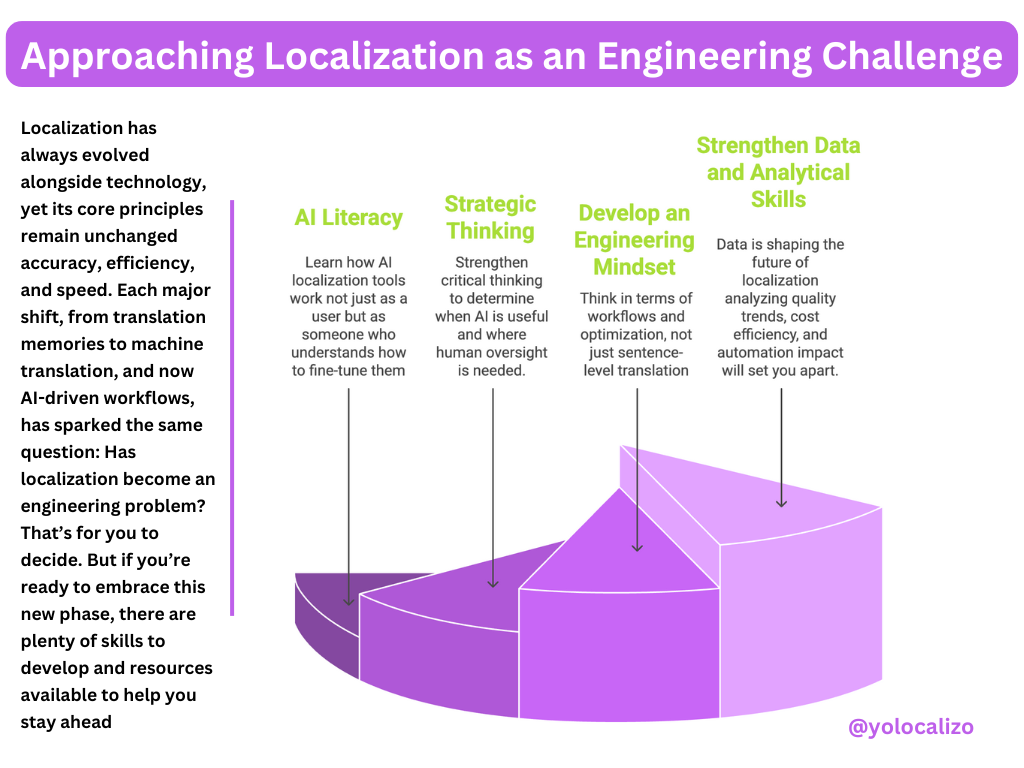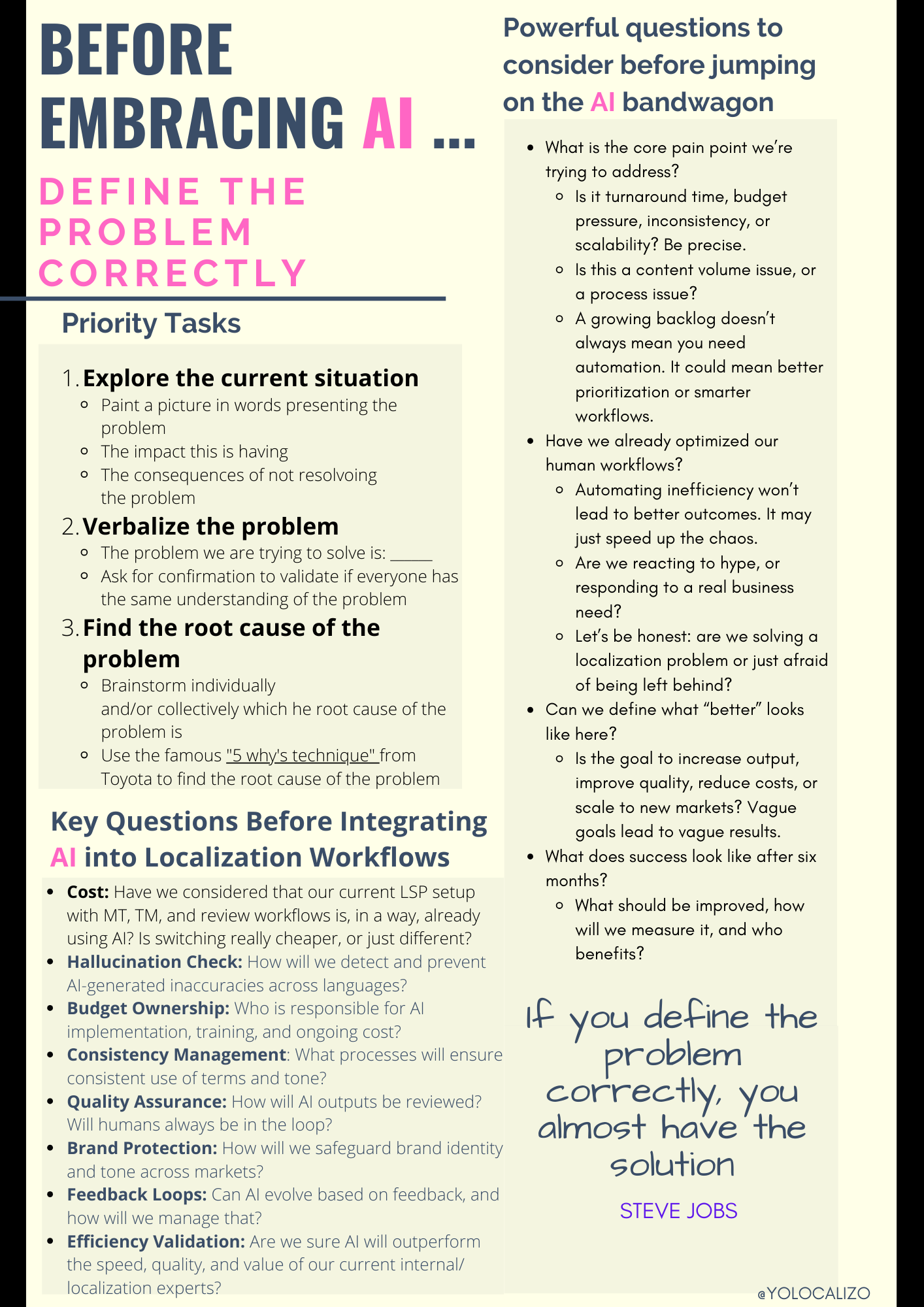Before jumping on the AI bandwagon: What localization problem are you trying to solve
Lately, I’ve been having many conversations with colleagues in the industry about the pressure they feel to embed AI in their workflows. I also get questions through my blog or LinkedIn, all around the same topic: the pressure that Localization professionals on the client side feel to implement AI as part of their localization workflows. Very often, this pressure comes from the classic keep up with the Joneses effect, from FOMO, or from reading a business case explaining how company X implemented AI in their workflows and achieved savings of XX%. Sometimes it also comes from someone out of the Localization team, typicallly someone from the Leadership team, product or even IT team after attending a conference where the benefits of using AI were presented, wher they saw a product demo that promises you’ll automate the entire localization process with the “push of a button.”
I’m not saying that AI can’t help us; it definitely can, but I am saying we need to be careful about assuming that just because something worked for another company, it will work for us too. Every company is unique. Each product can be very different. Every tech framework is different. And of course, it also depends heavily on the localization team's maturity, budget, and the number of people involved. In short, every case is different. So jumping on the bandwagon that promises AI is the solution to all our problems is, at the very least, questionable.
And speaking of problems… what exactly is the problem we’re trying to solve by implementing AI into our workflows? AI is a tool, not a Localization strategy. So again, what is the real problem we are trying to solve?
In many cases, the pressure a team receives to use AI at any cost, under the promise of cheaper, faster, is a case of FOMO disguised as innovation.
And that’s what this post is about. It’s not about debating whether AI should be implemented or not. It’s about helping anyone who finds themselves in this situation, whether due to external pressure or simply not being sure if AI will solve their problem, take a step back and reflect.
Because again:
What is the problem we are trying to solve?
Start by asking the right questions
Right now, it feels like AI is everywhere. There’s pressure to use it, test it, and talk about it. In localization, too, generative AI and LLMs are being explored as potential solutions for everything, from translation to LQA to content generation.
But before jumping on the AI bandwagon, we need to take a step back.
Are we solving the right problem?
This is a simple but essential question. Because no tool, no matter how powerful or trendy, can fix what hasn’t been clearly defined.
Before adding AI to your localization workflows, take a moment. The goal isn’t to use AI just because it’s there ; it’s to fix something that actually needs fixing.
But, what part of something? What’s the meaning actually of something here?
Resisting the pressure to implement AI is not easy, but the following questions and the overall framework I present in this infographic might help.
Click HERE to download the infographic
Use these guiding questions to understand if AI is truly the right path or if the problem lies elsewhere:
What is the core pain point we’re trying to address?
Is it turnaround time, budget pressure, inconsistency, or scalability? Be precise.Is this a content volume issue, or a process issue?
A growing backlog doesn’t always mean you need automation. It could mean better prioritization or smarter workflows.Have we already optimized our human workflows?
Automating inefficiency won’t lead to better outcomes. It may just speed up the chaos.Are we reacting to hype, or responding to a real business need?
Let’s be honest: are we solving a localization problem or just afraid of being left behind?Can we define what “better” looks like here?
Is the goal to increase output, improve quality, reduce costs, or scale to new markets? Vague goals lead to vague results.What does success look like after six months?
What should be improved, how will we measure it, and who benefits?
These questions help avoid solutions in search of a problem. They anchor your strategy in purpose,xº not in trend-following.
Acknowledge that AI is a tool; it’s not a strategy.
It’s important to be clear: AI can support our localization strategy, but should never replace it. AI can help by processing large volumes of content, spotting patterns, suggesting translations, or speeding up some review cycles. These are useful capabilities. But localization is much more than moving words from one language to another. It demands human judgment to prioritize what matters most when information is incomplete. It requires values to decide what fits and what doesn’t within a brand’s voice and market expectations. It needs real-world context to connect product goals, marketing realities, cultural nuances, and user experiences. But AI is just a tool. We don’t need to use it if it doesn’t add value. And we definitely shouldn’t let it dictate our strategy.
In conclusion
AI can definitely help us in localization, but only if we are clear about what we’re trying to fix. There is no doubt that there is pressure to implement it, but rushing just because others are doing it or because it looks good on paper is not the way. Every company, every team, and every product has its own reality, and what worked somewhere else might not work for us. That’s why it’s so important to start with the right questions, to be sure we’re solving the right problem, and not just following a trend. AI is a tool, not a strategy. If it adds real value, great , let’s use it. If it doesn’t, there’s no need to force it.
At the end of the day, our job is not to implement AI for its own sake. Our job is to solve problems that matter and adapt content for international clients worldwide.
So, again, what problem are we trying to solve by implementing AI in our Localization workflows?
Until next time.
@yolocalizo











Before jumping on the AI bandwagon: What localization problem are you trying to solve? AI is everywhere right now, including in localization.
But before jumping on the bandwagon, we need to stop and ask:
Are we solving the right problem?